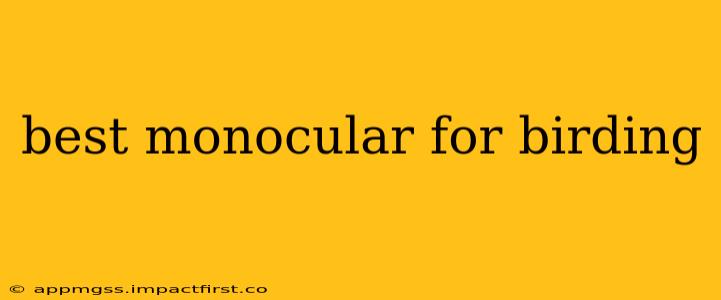Birding enthusiasts know that a good pair of binoculars is essential, but a monocular can be a surprisingly valuable addition to your birding toolkit. Lightweight, compact, and often more affordable than binoculars, a high-quality monocular can offer excellent magnification for close-up observation of birds, especially when weight and portability are key concerns. This guide will help you navigate the options and find the best monocular for your birding needs.
What to Look for in a Birding Monocular
Before diving into specific recommendations, let's consider the key features to prioritize when choosing a monocular for birdwatching:
-
Magnification: This is expressed as a number followed by "x" (e.g., 8x). Higher magnification brings distant birds closer, but it also reduces the field of view and may result in shakiness. For birding, 8x to 10x magnification is generally a good range. Anything higher may be too difficult to stabilize without a tripod.
-
Objective Lens Diameter: This is the diameter of the front lens, usually measured in millimeters (mm). A larger diameter gathers more light, making the monocular suitable for low-light conditions. For birding, a lens diameter of 25mm to 42mm is usually sufficient.
-
Field of View: This indicates how wide an area you can see through the monocular. A wider field of view is helpful for quickly locating and tracking birds in motion.
-
Image Quality and Clarity: Look for a monocular with high-quality lenses that provide sharp, clear images with minimal distortion. Read reviews to gauge the quality of the image produced.
-
Durability and Build Quality: A rugged monocular can withstand the rigors of fieldwork. Consider a monocular with a durable, waterproof, and shockproof design.
-
Weight and Size: Portability is often a significant factor for birders. A lightweight and compact monocular is easy to carry in a pocket or backpack.
-
Focusing Mechanism: A smooth, easy-to-use focus mechanism is crucial for quick adjustments when observing birds.
H2: What is the best magnification for a birding monocular?
The best magnification for a birding monocular often falls within the 8x to 10x range. Higher magnifications (e.g., 12x or 16x) can bring distant birds closer, but they often result in a narrower field of view and increased image shake, making it harder to track moving birds. 8x or 10x offers a good balance between magnification and stability, making them ideal for most birding situations.
H2: What features should I look for in a monocular for birdwatching?
Beyond magnification, several key features enhance a monocular's suitability for birdwatching:
- Low-light performance: Birds are often active at dawn and dusk. A monocular with a large objective lens diameter and high-quality optics will perform better in low-light conditions.
- Waterproof and fogproof: These features protect the monocular from the elements, ensuring its longevity and reliability in various weather conditions.
- Compact and lightweight design: Portability is crucial when birding, especially on long hikes or explorations. A lightweight monocular is much easier to carry for extended periods.
- Durable construction: A robust build quality ensures the monocular can withstand accidental drops or bumps during fieldwork.
- Good eye relief: This allows comfortable viewing even for eyeglass wearers.
H2: How much should I spend on a birding monocular?
The price of birding monoculars varies widely, depending on the features, quality, and brand. You can find basic monoculars for under $50, while higher-end models with advanced features can cost several hundred dollars. Generally, a good quality monocular suitable for birding will fall in the $75-$200 range. It's crucial to balance price with your needs and budget; you don't need to spend a fortune to get a useful monocular for birdwatching.
H2: Are monoculars good for birding?
Monoculars can be excellent tools for birding, especially in situations where portability and compactness are important. While binoculars offer a wider field of view and a stereoscopic 3D image, a monocular’s smaller size and weight are advantages for hikers or those who want a quick, lightweight option. They're particularly useful for situations where seeing a detail up close is prioritized over surveying a broad area.
This detailed guide helps you find the best monocular for birding. Remember to research specific models and read reviews before making your purchase. Happy birding!
